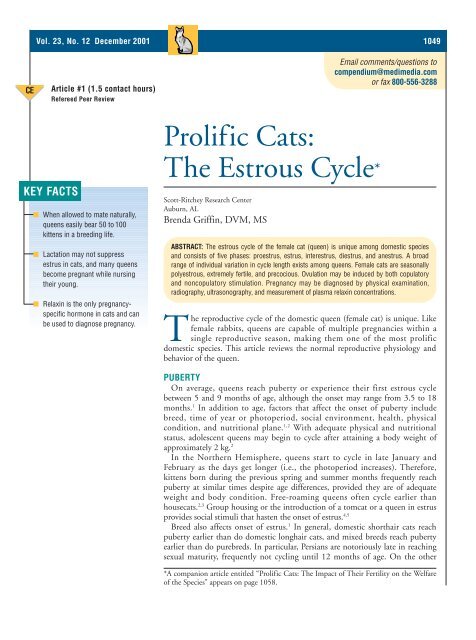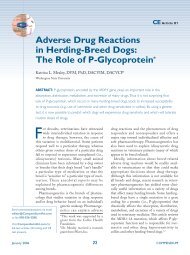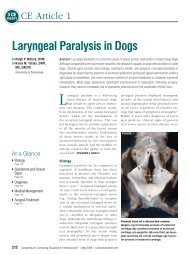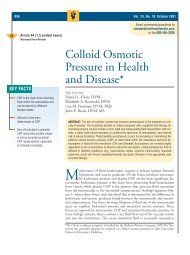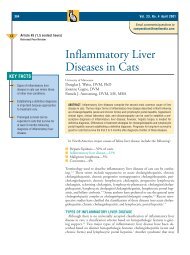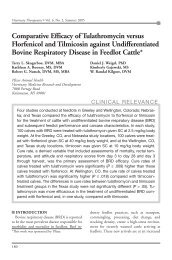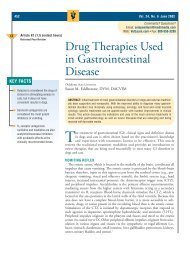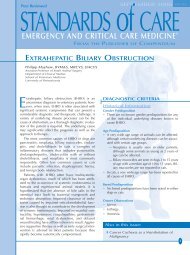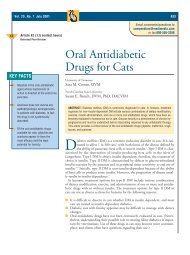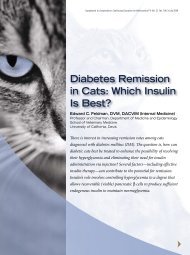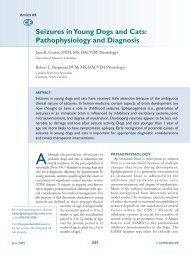Prolific Cats: The Estrous Cycle* - VetLearn.com
Prolific Cats: The Estrous Cycle* - VetLearn.com
Prolific Cats: The Estrous Cycle* - VetLearn.com
Create successful ePaper yourself
Turn your PDF publications into a flip-book with our unique Google optimized e-Paper software.
CE<br />
Vol. 23, No. 12 December 2001 1049<br />
Article #1 (1.5 contact hours)<br />
Refereed Peer Review<br />
KEY FACTS<br />
■ When allowed to mate naturally,<br />
queens easily bear 50 to 100<br />
kittens in a breeding life.<br />
■ Lactation may not suppress<br />
estrus in cats, and many queens<br />
be<strong>com</strong>e pregnant while nursing<br />
their young.<br />
■ Relaxin is the only pregnancyspecific<br />
hormone in cats and can<br />
be used to diagnose pregnancy.<br />
<strong>Prolific</strong> <strong>Cats</strong>:<br />
<strong>The</strong> <strong>Estrous</strong> <strong>Cycle*</strong><br />
Scott-Ritchey Research Center<br />
Auburn, AL<br />
Brenda Griffin, DVM, MS<br />
Email <strong>com</strong>ments/questions to<br />
<strong>com</strong>pendium@medimedia.<strong>com</strong><br />
or fax 800-556-3288<br />
ABSTRACT: <strong>The</strong> estrous cycle of the female cat (queen) is unique among domestic species<br />
and consists of five phases: proestrus, estrus, interestrus, diestrus, and anestrus. A broad<br />
range of individual variation in cycle length exists among queens. Female cats are seasonally<br />
polyestrous, extremely fertile, and precocious. Ovulation may be induced by both copulatory<br />
and noncopulatory stimulation. Pregnancy may be diagnosed by physical examination,<br />
radiography, ultrasonography, and measurement of plasma relaxin concentrations.<br />
<strong>The</strong> reproductive cycle of the domestic queen (female cat) is unique. Like<br />
female rabbits, queens are capable of multiple pregnancies within a<br />
single reproductive season, making them one of the most prolific<br />
domestic species. This article reviews the normal reproductive physiology and<br />
behavior of the queen.<br />
PUBERTY<br />
On average, queens reach puberty or experience their first estrous cycle<br />
between 5 and 9 months of age, although the onset may range from 3.5 to 18<br />
months. 1 In addition to age, factors that affect the onset of puberty include<br />
breed, time of year or photoperiod, social environment, health, physical<br />
condition, and nutritional plane. 1,2 With adequate physical and nutritional<br />
status, adolescent queens may begin to cycle after attaining a body weight of<br />
approximately 2 kg. 2<br />
In the Northern Hemisphere, queens start to cycle in late January and<br />
February as the days get longer (i.e., the photoperiod increases). <strong>The</strong>refore,<br />
kittens born during the previous spring and summer months frequently reach<br />
puberty at similar times despite age differences, provided they are of adequate<br />
weight and body condition. Free-roaming queens often cycle earlier than<br />
housecats. 2,3 Group housing or the introduction of a tomcat or a queen in estrus<br />
provides social stimuli that hasten the onset of estrus. 4,5<br />
Breed also affects onset of estrus. 1 In general, domestic shorthair cats reach<br />
puberty earlier than do domestic longhair cats, and mixed breeds reach puberty<br />
earlier than do purebreds. In particular, Persians are notoriously late in reaching<br />
sexual maturity, frequently not cycling until 12 months of age. On the other<br />
*A <strong>com</strong>panion article entitled “<strong>Prolific</strong> <strong>Cats</strong>: <strong>The</strong> Impact of <strong>The</strong>ir Fertility on the Welfare<br />
of the Species” appears on page 1058.
1050 Small Animal/Exotics Compendium December 2001<br />
hand, Burmese queens frequently cycle as early as 3.5<br />
to 4.5 months of age.<br />
SEASONALITY<br />
Free-roaming queens are seasonally polyestrous. In<br />
the Northern Hemisphere, the season begins in January<br />
or February (after the winter solstice, as the days get<br />
longer) and lasts until fall. <strong>The</strong> season for an average<br />
queen begins in February and ends in late September. 2<br />
Anestrus persists from October through December<br />
until the new season begins in January or February. A<br />
few queens, particularly those living in warm climates,<br />
may continue to cycle as late as November before<br />
entering a brief anestrous period.<br />
On average, queens display estrous behavior every 2<br />
weeks during the season unless one of the following<br />
occurs:<br />
• Pregnancy<br />
• Pseudopregnancy (ovulation without fertilization)<br />
• Sterilization<br />
• Serious illness<br />
<strong>The</strong> peak season is February to March and May to June<br />
(which shifts to July to August in northern, temperate<br />
climates). 2<br />
In contrast to free-roaming cats, indoor cats may be<br />
influenced by artificial lighting. In an environmentally<br />
controlled laboratory setting, 10 or more hours of light<br />
in a 24-hour period are required for reproductive cycling<br />
and allow queens to cycle throughout the year. 6<br />
Maintaining a 14-hour photoperiod and the use of<br />
natural-daylight spectrum fluorescent bulbs assures a<br />
maximum fertility period and estrous cycling. 7 <strong>Estrous</strong><br />
cycling typically occurs within 7 to 10 weeks of<br />
instituting such a light cycle 8,9 ; however, this period can<br />
be shortened if preceded by a nonstimulatory light<br />
cycle of 8 or fewer hours of light 5,10 or if a tomcat or<br />
queen in estrus is introduced at the time that the<br />
duration of light is increased. 4,5<br />
Although this response is predictable in a controlled<br />
laboratory setting, it is less predictable in a home<br />
environment because light patterns are rarely constant.<br />
<strong>The</strong> vast majority of housecats experience winter<br />
anestrus. 2 Siamese queens appear less sensitive to<br />
photoperiod than do other breeds and tend to cycle yearround.<br />
1 In contrast, longhaired cats are more sensitive to<br />
photoperiod and winter estrus in these cats is rare. 6<br />
FERTILITY<br />
<strong>The</strong> domestic queen has long been recognized for her<br />
fertility (Figure 1). In ancient Egypt, she was<br />
Figure 1—Domestic queens are excellent as well as prolific<br />
mothers, producing an average of two to three litters per year<br />
if allowed to breed uncontrolled.<br />
worshipped as a symbol of fertility. In fact, the<br />
Egyptian goddess of fertility, Bastet, was portrayed as a<br />
cat. Extreme examples of the domestic queen’s fertility<br />
exist in the literature, including a report of a 26-yearold<br />
queen successfully delivering kittens. 11 Another<br />
queen delivered a litter consisting of 19 kittens. 12<br />
Peak reproductive activity occurs between 1.5 and 8<br />
years of age, with an average of two to three litters per<br />
year and three to four kittens per litter (range, 1 to 15<br />
kittens per litter). 2 Queens easily bear 50 to 150 kittens<br />
in a breeding life of approximately 10 years if allowed<br />
to mate naturally. Adolescent queens (younger than 1<br />
year of age) and queens older than 8 years of age tend<br />
to cycle irregularly and have smaller litters, more<br />
abortions, and more stillbirths. 2 Despite their lack of<br />
optimal reproductive performance, however, adolescent<br />
queens and queens older than 8 years of age <strong>com</strong>monly<br />
have successful pregnancies.<br />
Like tomcats, queens are polygamous and rarely form<br />
long-term bonds with a mate, although they often<br />
display preferences for particular partners. 5,13 If allowed,<br />
a female may accept several males during the estrous<br />
period and therefore litters may have multiple sires (a<br />
phenomenon termed superfecundity).<br />
After normal lactation and weaning, queens return to<br />
estrus in 2 to 8 weeks (average, 4 weeks). 2 In many<br />
queens, lactation does not suppress estrus and a return<br />
to fertile cycling is seen during the second to fifth week<br />
of lactation. 14 If a queen aborts or if the litter is taken<br />
away within 3 days of parturition, she will return to<br />
estrus in approximately 1 week. 2 Some queens<br />
experience estrus during pregnancy. In fact, 10% of<br />
female cats experience estrus between the third and sixth<br />
weeks of pregnancy. 1 Fertile cycles are rare in pregnant<br />
queens, but the development of fetuses of different ages
Compendium December 2001 Small Animal/Exotics 1051<br />
resulting from separate matings in different estrous<br />
cycles (known as superfetation) can occur. 1<br />
ESTROUS CYCLE<br />
<strong>The</strong> feline estrous cycle consists of five phases:<br />
proestrus, estrus, interestrus, diestrus, and anestrus<br />
(Table 1).<br />
Proestrus<br />
Proestrus is the first phase and is the time during<br />
which queens attract toms but are not sexually<br />
receptive to them. Rapid ovarian follicular growth and<br />
estradiol synthesis occur during this phase. Queens<br />
typically vocalize; rub their faces against objects, other<br />
cats, or human <strong>com</strong>panions; and act “friendly.”<br />
Rubbing usually progresses to rolling, and many queens<br />
stretch and squirm in lateral recumbency, opening and<br />
closing their paws. Queens may assume a lordosis<br />
stance and tread in place with their hindlimbs. Upon<br />
introduction to a tomcat, however, they will not be<br />
sexually receptive and may aggressively turn on the<br />
male, hissing and striking out with their claws.<br />
Proestrus can last from 12 hours to 3 days. 2,14,15 Signs<br />
may be overt or subtle—in fact, proestrus is not<br />
observed regularly in all queens. Many queens shift<br />
abruptly from no display of sexual behavior to<br />
standing, receptive heat.<br />
Estrus<br />
Estrus is the phase of sexual receptivity that lasts an<br />
average of 4 to 7 days, with a range of 1 to 21<br />
days. 2,14–17 During this period, serum estradiol concentrations<br />
rise sharply. Under the influence of estradiol,<br />
Table 1. <strong>The</strong> <strong>Estrous</strong> Cycle of the Domestic Cat<br />
the labia of the queen’s vulva be<strong>com</strong>e slightly<br />
edematous and hyperemic but remain small and well<br />
covered by hair, requiring close inspection to identify<br />
changes. Vulvar discharge is scant and, because of the<br />
fastidious grooming habits of queens, rarely observed.<br />
During estrus, queens <strong>com</strong>monly vocalize and call to<br />
toms when approached. <strong>The</strong>y crouch and posture in a<br />
lordosis stance, treading in place with their hindlimbs.<br />
In this position, the queen’s ventral thorax and<br />
abdomen touch the floor, her perineum is elevated, and<br />
her tail is deflected laterally as she presents herself to<br />
her mate. This stance can usually be induced by<br />
stroking the queen’s back or dorsal rump during estrus.<br />
Occasionally, estrual queens exhibit urine spraying and<br />
marking. 2<br />
Interestrus<br />
Because cats are polyestrous and do not ovulate after<br />
every estrus phase, an interestrous period (or<br />
nonestrous interval) <strong>com</strong>monly follows estrus.<br />
Interestrus is the interval of sexual inactivity between<br />
waves of follicular function in cycling queens. During<br />
this period, serum estradiol concentrations rapidly<br />
return to basal levels and all breeding behaviors cease.<br />
Queens typically return to proestrus within 1 to 3<br />
weeks, although the length of this period varies and<br />
may range from 3 days to 7 weeks. 2,14–17<br />
Diestrus<br />
If ovulation occurs during estrus, diestrus follows.<br />
Corpora lutea form within 24 to 48 hours of ovulation<br />
and begin secreting progesterone. 2 <strong>The</strong>y remain<br />
functional for 30 to 50 days (averge 35 days) in<br />
Proestrus Estrus Interestrus Diestrus Anestrus<br />
Duration 0.5–3 days Average: 4–7 days Average: 1–3 weeks Average: 35 days October/November–<br />
Range: 1–21 days Range: 3 days–7 weeks Range: 30–50 days January/February<br />
(luteal function) (free-roaming cats)<br />
Signs Rubbing and rolling Sexually receptive None None; breeding None<br />
Affectionate behavior Lordosis activity ceases<br />
Lordosis Treading for 30–100<br />
Treading Tail deflection days (average<br />
Not receptive to tomcats Vocalization 45–50 days)<br />
Vocalization<br />
Hormone Ovarian follicular Follicular phase; Baseline estradiol Formation of Baseline<br />
Activity growth and sharp increase and progesterone corpora lutea; estradiol and<br />
estradiol synthesis in estradiol concentrations progesterone progesterone<br />
concentrations dominant phase concentrations
1052 Small Animal/Exotics Compendium December 2001<br />
nonpregnant queens, at which time regression occurs.<br />
An interestrous interval follows, such that diestral<br />
queens cease breeding activity for 35 to 100 days<br />
(average 45 to 50 days) before proestrus/estrus<br />
resumes. 16,18 Because breeding activity ceases during this<br />
phase, it is behaviorally indistinguishable from anestrus<br />
or interestrus.<br />
On rare occasions, queens exhibit behavioral signs of<br />
estrus at the conclusion of diestrus as progesterone<br />
concentrations decline to basal levels. 5 In such cases,<br />
hormonal estrus is absent and estradiol concentrations<br />
remain at basal levels. 5<br />
Anestrus<br />
Anestrus is the period of sexual rest that occurs<br />
between October and January in most free-roaming<br />
queens. Anestrus queens are sexually noninviting and<br />
nonreceptive. <strong>The</strong>y may hiss or strike out at toms<br />
making sexual advances.<br />
BREEDING BEHAVIOR<br />
Courtship usually occurs at night. Receptive queens<br />
sit at a distance from <strong>com</strong>peting males and crouch, roll,<br />
and tread in place. Fighting may occur between males<br />
as they mark out territories surrounding females.<br />
Vocalization is not limited to fighting and is more often<br />
associated with courtship and mating. Queens utter<br />
low monotone howls known as heat cries, while males<br />
caterwaul in response, signaling their readiness to<br />
mate. 1 A male may approach a receptive female and rub<br />
chins and faces with her before mating. Courtship lasts<br />
from 10 seconds to 5 minutes, and the duration<br />
decreases with repeated breedings. 1 Mating is<br />
ac<strong>com</strong>plished as the tom grasps the female by the neck<br />
with his teeth, grips her forequarters with his front legs,<br />
and straddles her with his hindlimbs. Intromission and<br />
ejaculation occur within a few seconds (Figure 2).<br />
After the tom releases his grip, he rapidly retreats as<br />
the female displays a postcoital “after-reaction,’’ which<br />
lasts up to several minutes. <strong>The</strong> after-reaction is characterized<br />
by a loud scream (the copulatory scream),<br />
followed immediately by vigorous rubbing and rolling<br />
on the ground or floor and licking of the vulva. 1 During<br />
this time, the queen is unreceptive to the male and if he<br />
approaches, she will strike out at him. Additional<br />
matings, with the same or different tomcats, usually<br />
resume within 20 to 30 minutes. 1 Several matings (10 to<br />
30) <strong>com</strong>monly occur during the next 24 hours and<br />
continue over several days with the interval between<br />
matings be<strong>com</strong>ing increasingly longer. 1 Coital contact<br />
does not shorten the queen’s period of receptivity. 2,17<br />
An after-reaction may occur in some estrual queens<br />
following mechanical stimulation, such as petting<br />
Figure 2A<br />
Figure 2B<br />
Figure 2C<br />
Figure 2—Mating sequence of the domestic cat. (A) An<br />
interested male approaches a queen in estrus. (B) As the tom<br />
prepares to grasp her neck, the queen exhibits lordosis and<br />
tail deflection. (C) <strong>The</strong> tom mounts the queen. Intromission<br />
and ejaculation occur within 5 to 15 seconds.
Compendium December 2001 Small Animal/Exotics 1053<br />
down the back or scratching the dorsal rump. Owners<br />
can be quite alarmed by this behavior, often confusing<br />
it with a seizure. Similarly, owners may not recognize<br />
normal estrous behaviors and may mistake excessive<br />
lordosis and treading for seizure activity in their cats.<br />
OVULATION AND PSEUDOPREGNANCY<br />
<strong>The</strong> domestic cat is an induced ovulator. Until<br />
recently, queens were believed to require copulation or<br />
direct mechanical stimulation of the vagina and cervix<br />
to ovulate. Release of luteinizing hormone (LH) from<br />
the anterior pituitary occurs within minutes of<br />
copulation in cats, with subsequent ovulation occurring<br />
in 30 to 50 hours. 19 A linear relationship exists between<br />
the number of sexual contacts, the magnitude and<br />
duration of LH release, and the likelihood of successful<br />
ovulation. 18<br />
Ovulation induced by noncopulatory stimulation<br />
can also occur in cats and is much more <strong>com</strong>mon than<br />
previously believed. Numerous studies have<br />
demonstrated progesterone concentrations consistent<br />
with ovulation in nonbred queens. 5,16,19,20 Luteal phase<br />
diseases, including feline inflammatory uterine disease<br />
and pyometra, occur in individually housed or nonbred<br />
queens. 16,21 Types of noncopulatory stimulation<br />
that induce ovulation may include the stroke of<br />
a hand down the back; other physical stimulation;<br />
or visual, auditory, or olfactory cues from a nearby<br />
tomcat. 16,19,22<br />
Pseudopregnancy occurs when a queen ovulates but<br />
does not be<strong>com</strong>e pregnant. Corpora lutea develop as a<br />
result of ovulation and synthesize and secrete progesterone.<br />
Progesterone inhibits secretion of gonadotropinreleasing<br />
hormone from the hypothalamus and hence<br />
LH and follicle-stimulating hormone from the anterior<br />
pituitary. <strong>The</strong> pseudopregnant queen does not exhibit<br />
estrus while under the influence of progesterone. She<br />
ceases breeding behavior for 35 to 100 days (average 45<br />
to 50 days). 2,16 <strong>Cats</strong> differ from bitches and other<br />
carnivores in that the luteal phase of nonpregnant<br />
queens is only half as long as gestation, allowing a more<br />
rapid return to a fertile state. 2 In addition, clinical signs<br />
of pseudopregnancy (pseudocyesis) are very rare in cats.<br />
When present, they are usually mild but may include<br />
lactation, nesting, and tending kittens. 2<br />
PREGNANCY<br />
In free-roaming queens, there is a bimodal incidence<br />
of pregnancy: Most kittens are born in midspring and<br />
late summer. 3 Some queens have a third litter in late<br />
fall. <strong>The</strong> queen’s gestation period is 65 to 67 days on<br />
average, with a range of 62 to 71 days. 17 Gestation<br />
length is variable due to the relatively long period of<br />
sexual receptivity and the uncertainty of the time of<br />
ovulation and conception. <strong>The</strong> gestation period may be<br />
divided into three trimesters, each approximately 3<br />
weeks in duration.<br />
Pregnant cats should be allowed moderate exercise<br />
and should be fed a high-quality feline diet designed<br />
for growth or lactation. Caloric intake increases by<br />
approximately one third by midgestation. 23 Stress<br />
should be avoided in pregnant queens and a quiet,<br />
warm, dark nesting area should be provided during the<br />
last trimester.<br />
PREGNANCY DIAGNOSIS<br />
Behavioral and physical changes may aid in<br />
pregnancy diagnosis, but such changes are typically<br />
subtle during the first two trimesters. Many queens<br />
be<strong>com</strong>e increasingly docile during this period and<br />
exhibit “pinking” of the nipples (the nipples be<strong>com</strong>e<br />
pinker and more erect). 1 (Ironically, in the author’s<br />
experience, cats in the early stages of pregnancy, when<br />
physical signs of their condition are lacking, are<br />
frequently offered for adoption by humane shelters<br />
because of their docile, friendly temperaments.) By the<br />
third trimester, behavioral and physical changes are<br />
obvious and include abdominal distention,<br />
enlargement of the mammary glands, excessive<br />
grooming of the mammary and perineal areas, and<br />
nesting behavior (Figure 3).<br />
Relaxin is the only pregnancy-specific hormone in<br />
cats. 24 Pregnancy gonadotropins are not known to exist,<br />
and serum progesterone concentrations are not helpful<br />
in diagnosing pregnancy because they do not significantly<br />
differ in pregnant and pseudopregnant queens. 2<br />
Plasma relaxin assays (Witness ® Relaxin, Synbiotics<br />
Corp, San Diego, CA) may be used to diagnose<br />
pregnancy in dogs after day 22 to 24 of pregnancy 25<br />
Figure 3—Although physical changes remain subtle during<br />
the first two trimesters of pregnancy, they be<strong>com</strong>e obvious<br />
after the sixth or seventh week. Note the abdominal<br />
distention and mammary development.
Compendium December 2001 Small Animal/Exotics 1055<br />
and may be<strong>com</strong>e available for use in cats. Preliminary data suggest that<br />
this assay is useful after 26 to 28 days of pregnancy in cats. 26 Relaxin is<br />
secreted by the placenta. Plasma relaxin concentrations increase from<br />
days 20 to 30 after mating and remain elevated throughout pregnancy<br />
and for the first few days after birth. <strong>The</strong> luteotrophic effects of relaxin<br />
help to maintain pregnancy and result in relaxation or softening of the<br />
connective tissues of the pelvis. 24<br />
Abdominal palpation is the most <strong>com</strong>mon method for diagnosing<br />
pregnancy in queens. 2 Fetuses may first be palpated at day 17 (2.5 weeks<br />
of gestation) as discrete, firm, spherical nodules that are 2 to 2.5 cm in<br />
diameter. By day 25 (3.5 weeks of gestation), fetuses are no longer<br />
discretely palpable. Instead, generalized uteromegaly is evident and<br />
remains palpable through parturition. By week 7 of gestation, fetal heads<br />
can be palpated. With experience, palpation is very reliable for detecting<br />
pregnancy and is the most economical and practical method. 27<br />
Imaging methods used for pregnancy diagnosis include radiography and<br />
ultrasonography. Calcification of the fetal skeletons may occur as early as<br />
day 38 of gestation but is not a reliable finding until day 43. <strong>The</strong>refore, to<br />
ensure diagnostic results, radiography should be performed after day 43 of<br />
gestation. 2 Uteromegaly may be seen before this time but cannot be distinguished<br />
from pyometra or other inflammatory uterine diseases. Abdominal<br />
radiographs are most useful for evaluating litter size before parturition.<br />
Ultrasonography is rapid, safe, and reliable for pregnancy detection in cats.<br />
Ultrasonographic evidence of pregnancy may be seen as early as 11 to 14<br />
days, and fetal heartbeats can be recognized at 3.5 to 4 weeks of gestation. 28<br />
REFERENCES<br />
1. Beaver BV: Female feline sexual behavior, in Beaver BV (ed): Feline Behavior: A Guide<br />
for Veterinarians. Philadelphia, WB Saunders Co, 1992, pp 141–169.<br />
2. Feldman EC, Nelson RW: Feline reproduction, in Feldman EC, Nelson RW (eds):<br />
Canine and Feline Endocrinology and Reproduction. Philadelphia, WB Saunders Co,<br />
1996, pp 741–767.<br />
3. Schmidt PM: Feline breeding management. Vet Clin North Am Small Anim Pract<br />
16:435–449, 1986.<br />
4. Michel C: Induction of oestrus in cats by photoperiodic manipulations and social<br />
stimuli. Lab Anim 27:278–280, 1993.<br />
5. Griffin B: Unpublished data, Scott-Ritchey Research Center, Auburn, AL, 1999.<br />
6. Shille VM, Sojka NJ: Feline reproduction, in Ettinger SJ, Feldman EC (eds): Textbook<br />
of Veterinary Internal Medicine. Philadelphia, WB Saunders Co, 1995, p 1690.<br />
7. Griffin B, Baker HJ: Domestic cats as laboratory animals, in Fox JG (ed): Laboratory<br />
Animal Medicine. San Diego, CA, Academic Press, 2001.<br />
8. Dawson AB: Early estrus in the cat following increased illumination. Endocrinology<br />
28:907–910, 1941.<br />
9. Scott PP, Lloyd-Jacob MA: Reduction in the anoestrus period of laboratory cats by<br />
increased illumination. Nature 184:2022, 1959.<br />
10. Hurni H: Day length and breeding in the domestic cat. Lab Anim 15:229–233, 1981.<br />
11. Comfort A: Maximum ages reached by domestic cats. J Mammol 37:118–119, 1956.<br />
12. Brown K: Why Do <strong>Cats</strong> Wear Pajamas? Kansas City, MO, Andrews McMeel, 2001.<br />
13. Voith VL: Feline reproductive behavior, in Morrow DE (ed): Current <strong>The</strong>rapy in<br />
<strong>The</strong>riogenology. Philadelphia, WB Saunders Co, 1980, pp 839–843.<br />
14. Lofstedt RM: <strong>The</strong> estrous cycle of the domestic queen. Compend Contin Educ Pract<br />
Vet 4(1):52–58, 1982.<br />
15. Shille VM, Lundstrom KE, Stabenfeldt GH: Follicular function in the domestic cat as<br />
determined by estradiol 17b concentrations in plasma: Relation to estrous behavior
1056 Small Animal/Exotics Compendium December 2001<br />
and cornification of vaginal epithelium. Biol Reprod<br />
21:953–963, 1979.<br />
16. Griffin B: Lessons in reproductive physiology and behavior in<br />
domestic queens from noninvasive monitoring [abstract]. Proc<br />
ACVIM:855, 2001.<br />
17. Root MV, Johnston SD, Olson PN: <strong>Estrous</strong> length, pregnancy<br />
rate, gestation and parturition lengths, litter size and juvenile<br />
mortality in the domestic cat. JAAHA 31:429–432, 1995.<br />
18. Concannon P, Hodgson B, Lein D: Reflex LH release in estrous<br />
cats following single and multiple copulations. Biol Reprod<br />
23:111–117, 1980.<br />
19. Lawler DF, Johnston SD, Hegstad RL, et al: Ovulation without<br />
cervical stimulation in domestic cats. J Reprod Fertil Suppl 47:<br />
57–61, 1993.<br />
20. Potter K, Hancock DH, Gallina AM: Clinical and pathologic<br />
features of endometrial hyperplasia, pyometra, and endometritis<br />
in cats: 79 cases (1980–1985). JAVMA 198:1427–1431, 1991.<br />
21. Lawler DF, Evans RH, Reimers TJ, et al: Histopathologic<br />
features, environmental factors and serum estrogen progesterone<br />
and prolactin values associated with ovarian phase and inflammatory<br />
uterine disease in cats. Am J Vet Res 52:1747–1753,<br />
1991.<br />
22. Gudermuth DF, Newton L, Daels P, Concannon P: Incidence of<br />
spontaneous ovulation in young, group-housed cats based on<br />
serum and fecal concentrations of progesterone. J Reprod Fertil<br />
Suppl 51:177–184, 1997.<br />
23. Buffington CA: Meeting the nutritional needs of your feline<br />
patient. Vet Med 86:720–727, 1991.<br />
24. Verstegen JP: Physiology and endocrinology of reproduction in<br />
female cats, in England GC, Harvey M (eds): Manual of Small<br />
Animal Reproduction and Neonatology. Cheltenham, UK, British<br />
Small Animal Veterinary Assoc Pub, 1998, pp 11–16.<br />
25. Syniotics Corp, Witness ® Relaxin Validation Data, School of<br />
Veterinary Medicine, Lyon, France, 2001.<br />
26. Hillman LA, Griffin B: Unpublished data, Scott-Ritchey<br />
Research Center, Auburn, AL, 2001.<br />
27. Lawler DF, Bebiak DM: Nutrition and management of<br />
reproduction in the cat. Vet Clin North Am Small Anim Pract<br />
16:495–519, 1986.<br />
28. Mattoon JS, Nyland TG: Ultrasonography of the genital system,<br />
in Mattoon JS, Nyland TG (eds): Veterinary Diagnostic<br />
Ultrasonography. Philadelphia, WB Saunders Co, 1995, pp<br />
141–164.<br />
ARTICLE<br />
CE<br />
#1 CE TEST<br />
<strong>The</strong> article you have read qualifies for 1.5 contact<br />
hours of Continuing Education Credit from<br />
the Auburn University College of Veterinary Med-<br />
icine. Choose the best answer to each of the follow-<br />
ing questions; then mark your answers on the<br />
postage-paid envelope inserted in Compendium.<br />
1. On average, queens reach puberty at what age?<br />
a. 3 to 6 months d. 18 months<br />
b. 5 to 9 months e. 2 years<br />
c. 1 year<br />
2. Queens are seasonally polyestrous. <strong>The</strong> season usually<br />
begins and ends, respectively, in which of the following<br />
months?<br />
a. January, August<br />
b. February, September<br />
c. early March, late October<br />
d. late September, early March to April<br />
e. April to May, October<br />
3. Queens<br />
a. may experience estrus during pregnancy.<br />
b. may experience estrus while lactating.<br />
c. are not likely to be<strong>com</strong>e pregnant if they are<br />
younger than 14 months of age.<br />
d. a and b<br />
e. none of the above<br />
4. In queens, estrus<br />
a. is the phase of sexual receptivity.<br />
b. lasts an average of 4 to 7 days.<br />
c. is usually followed by the interestrous interval if<br />
pregnancy does not occur.<br />
d. is occasionally associated with urine spraying.<br />
e. all of the above<br />
5. <strong>The</strong> after-reaction<br />
a. occurs following mating and shortens the queen’s<br />
period of receptivity.
Compendium December 2001 Small Animal/Exotics 1057<br />
b. occurs following diestrus and indicates a return to<br />
estrus.<br />
c. is characterized by a loud scream, vigorous rubbing,<br />
rolling, and licking of the vulva.<br />
d. is associated with successful ovulation.<br />
e. a and c<br />
6. Which of the following statements regarding ovulation<br />
in cats is true?<br />
a. <strong>Cats</strong> are induced ovulators.<br />
b. <strong>Cats</strong> are spontaneous ovulators.<br />
c. Progesterone concentrations increase after<br />
ovulation.<br />
d. Both copulatory and noncopulatory stimuli may<br />
induce ovulation in cats.<br />
e. a, c, and d<br />
7. <strong>The</strong> luteal phase of cats<br />
a. is characterized by increased serum progesterone<br />
concentrations.<br />
b. is frequently associated with pseudocyesis.<br />
c. is <strong>com</strong>monly associated with estrous behavior,<br />
including lordosis and treading.<br />
d. results in cessation of breeding behavior for an<br />
average of 45 to 50 days.<br />
e. a and d<br />
8. <strong>The</strong> normal gestation period of cats averages _______<br />
days.<br />
a. 45 to 48 d. 72 to 75<br />
b. 58 to 60 e. 77 to 79<br />
c. 65 to 67<br />
9. <strong>The</strong> hormone relaxin<br />
a. is a pregnancy gonadotropin found in feline urine.<br />
b. is as reliable as serum progesterone for diagnosing<br />
pregnancy in cats.<br />
c. is the only pregnancy-specific hormone in cats.<br />
d. a and b<br />
e. a and c<br />
10. Which of the following statements regarding<br />
pregnancy diagnosis in cats is true?<br />
a. Fetuses can first be palpated at approximately 2.5<br />
weeks of gestation.<br />
b. Calcification of fetal skeletons occurs by day 43,<br />
after which time radiographs are useful for<br />
pregnancy diagnosis.<br />
c. Ultrasonography is a reliable method of pregnancy<br />
detection in cats.<br />
d. b and c<br />
e. all of the above


